
Citrus is a genus of flowering trees and shrubs in the rue family, Rutaceae. Plants in the genus produce citrus fruits, including crops such as oranges, mandarins, lemons, grapefruits, pomelos, and limes. The genus Citrus is native to South Asia, East Asia, Southeast Asia, Melanesia, and Australia. Various citrus species have been used and domesticated by indigenous cultures in these areas since ancient times. From there its cultivation spread into Micronesia and Polynesia by the Austronesian expansion ; and to the Middle East and the Mediterranean via the incense trade route, and onwards to Europe and the Americas.

Calamansi, also known as calamondin, Philippine lime, or Philippine lemon, is a citrus hybrid cultivated predominantly in the Philippines. It is native to the Philippines, parts of Indonesia, Malaysia, and Brunei, as well as parts of southern China and Taiwan.

Marmalade is a fruit preserve made from the juice and peel of citrus fruits boiled with sugar and water. The well-known version is made from bitter orange. It is also made from lemons, limes, grapefruits, mandarins, sweet oranges, bergamots, and other citrus fruits, or a combination. Citrus is the most typical choice of fruit for marmalade, though historically the term has often been used for non-citrus preserves.

The mandarin orange, also known as mandarin or mandarine, is a small, rounded citrus tree fruit. Treated as a distinct species of orange, it is usually eaten plain or in fruit salads. Tangerines are a group of orange-colored citrus fruit consisting of hybrids of mandarin orange with some pomelo contribution.

Citrus myrtifolia (chinotto), the myrtle-leaved orange tree, is a species of Citrus with foliage similar to that of the common myrtle. It is a compact tree with small leaves and no thorns which grows to a height of three metres (10 ft) and can be found in Malta, Libya, the south of France, and Italy (primarily in Liguria, typically Savona, and also in Tuscany, Sicily, and Calabria).
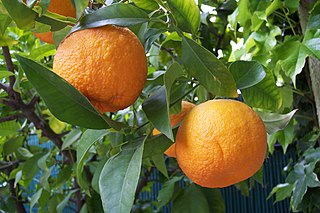
Bitter orange, sour orange, Seville orange, bigarade orange, or marmalade orange is in a narrow sense the citrus tree Citrus × aurantium and its fruit. It is native to Southeast Asia and has been spread by humans to many parts of the world. It is probably a cross between the pomelo, Citrus maxima, and the mandarin orange, Citrus reticulata.

Citrus unshiu is a semi-seedless and easy-peeling citrus species, also known as the satsuma mandarin or Japanese mandarin. During the Edo period of Japan, kishu mikans were more popular because there was a popular superstition that eating Citrus unshiu without seeds made people prone to infertility. Citrus unshiu became popular in Japan after modernization started in the Meiji period. It was introduced to the West from the Satsuma region of Japan in 1878.

Yuzu is a citrus fruit and plant in the family Rutaceae of East Asian origin. Yuzu has been cultivated mainly in East Asia, though it has also recently been grown in New Zealand, Australia, Spain, Italy, and France.
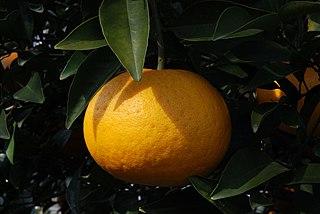
Amanatsu or kawano natsu daidai is a yellow citrus fruit, a cultivar that originated as a mutation of the natsu mikan or natsu daidai. It was discovered in 1935 in Tsukumi, Oita Prefecture, Japan. The original natsu mikan that served as the basis for amanatsu was found in Yamaguchi Prefecture around 1700.

Sudachi is a small, round, green citrus fruit of Japanese origin that is a specialty of Tokushima Prefecture in Japan. It is a sour citrus, not eaten as fruit, but used as food flavoring in place of lemon or lime. Genetic analysis shows it to be the product of a cross between a yuzu and another citrus akin to the koji and tachibana orange.

The Key lime or acid lime is a citrus hybrid native to tropical Southeast Asia. It has a spherical fruit, 2.5–5 centimetres in diameter. The Key lime is usually picked while it is still green, but it becomes yellow when ripe.
Curaçao is a liqueur flavored with the dried peel of the bitter orange variety laraha, a citrus fruit grown on the Caribbean island of Curaçao.
Laraha, or Curaçao orange, is the name of a citrus tree that grows on the island of Curaçao, and also the fruit of this tree. The name is cognate with Portuguese laranja for the orange. A descendant of the orange, the fruit of the laraha is too bitter and too fibrous to be considered edible.
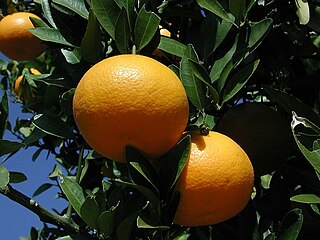
The iyokan, also known as anadomikan (穴門みかん) and Gokaku no Iyokan, is a Japanese citrus fruit, similar in appearance to a mandarin orange, with Dancy as the pollen parent and Kaikokan as the seed parent. It is the second most widely produced citrus fruit in Japan after the satsuma mandarin. Ehime Prefecture accounted for 90% of Iyokan production in 2021.

Kagami mochi is a traditional Japanese New Year decoration. It usually consists of two round mochi, the smaller placed atop the larger, and a daidai with an attached leaf on top. In addition, it may have a sheet of konbu and a skewer of dried persimmons under the mochi. It sits on a stand called a sanpō (三宝) over a sheet called a shihōbeni (四方紅), which is supposed to ward off fires from the house for the following years. Sheets of paper called gohei (御幣) folded into lightning shapes similar to those seen on sumo wrestler's belts are also attached.
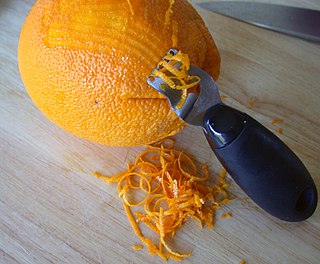
Zest is a food ingredient that is prepared by scraping or cutting from the rind of unwaxed citrus fruits such as lemon, orange, citron, and lime. Zest is used to add flavor to foods.
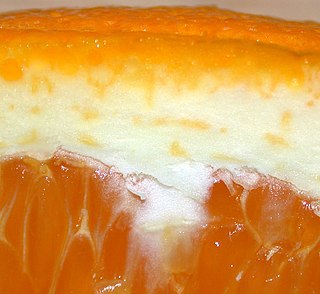
Peel, also known as rind or skin, is the outer protective layer of a fruit or vegetable which can be peeled off. The rind is usually the botanical exocarp, but the term exocarp also includes the hard cases of nuts, which are not named peels since they are not peeled off by hand or peeler, but rather shells because of their hardness.

The Kojiki and Nihon Shoki, compiled in the 700s, were the first books in Japan to describe citrus fruits. The Nihon Shoki states that a man named Tajimamori brought back citrus fruits from the Tokoyo no kuni on the orders of Emperor Suinin, which is thought to refer to the tachibana orange that grows wild in Japan. The Man'yōshū, a collection of poems from the same period, contains many poems about tachibana orange, and because of its strong acidity at the time, it was dried and used for medicinal and ornamental purposes rather than for food. The Kokin Wakashū, compiled in the 900s, mentions that tachibana orange was burned and used as incense to give a nice fragrance to kimonos. In Japan, tachibana orange is a symbol of eternity and is the motif for the Order of Culture.

Succade is the candied peel of any of the citrus species, especially from the citron or Citrus medica which is distinct with its extra-thick peel; in addition, the taste of the inner rind of the citron is less bitter than those of the other citrus. However, the term is also occasionally applied to the peel, root, or even entire fruit or vegetable like parsley, fennel and cucurbita which have a bitter taste and are boiled with sugar to get a special "sweet and sour" outcome.

Citrus taxonomy refers to the botanical classification of the species, varieties, cultivars, and graft hybrids within the genus Citrus and related genera, found in cultivation and in the wild.


















